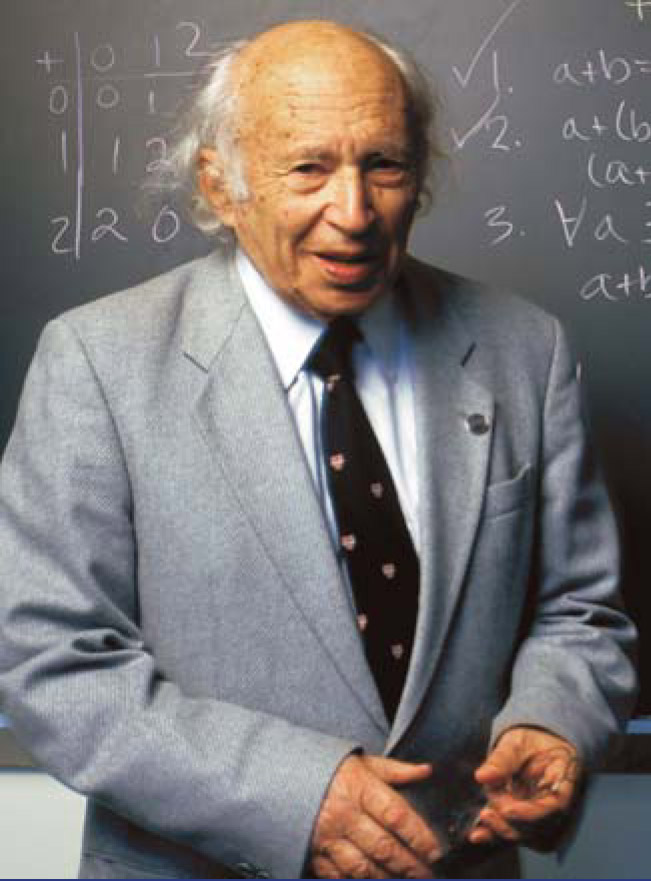Israel Moiseevich Gelfand
DOI: 10.1063/1.3480085
Israel Moiseevich Gelfand—one of the most original and versatile mathematicians, whose contributions had a profound effect on the study of theoretical and quantum physics—died in New Brunswick, New Jersey, on 5 October 2009.
Gelfand was born on 2 September 1913 in the small town of Okny near Odessa in Russia. He was expelled from school in the ninth grade because he was the son of a “bourgeois element” —his father was a mill manager—so he learned mathematics on his own. In a 1989 interview with the Russian magazine Kvant, translated into English for Quantum in 1991, he recounted, “It’s my deeply held conviction that mathematical ability in most future professional mathematicians appears precisely at that time—at 13 to 16 years of age. … This early period formed my style of doing mathematics. The subject of my studies varied, of course, but the artistic form of mathematics that took root … became the basis of my taste in choosing problems that continue to attract me right up to the present time.”
In 1930 Gelfand moved to Moscow. His next twist of fate was one of many paradoxes of Soviet life. Because of his status as a bourgeois element’s son, he could not enroll as an undergraduate student at a university. However, at 18 he taught at a technical college, and at 19 he entered the PhD program at Moscow State University without a diploma from college or even high school. The reason was simple: Although the Soviet Union used all possible resources to provide an education for the future elite that had “proletarian origins” and to keep others out of higher education, it did not bother to regulate graduate schools at that time.
Gelfand’s thesis adviser was Andrei Kolmogorov, who taught that a true mathematician must be a philosopher of nature. In 1935 Gelfand defended his thesis, “Abstract Functions and Linear Operators,” and in 1940 he obtained a doctor of science degree. In 1933 he began teaching at Moscow State. He became a full professor in 1943 but lost the position temporarily in 1952 during Joseph Stalin’s anti-Semitic campaign. He worked at the Steklov Mathematical Institute starting in 1939, and in 1953 he moved to the Institute of Applied Mathematics. After World War II he took part in the Soviet version of the Manhattan Project.
In 1989 Gelfand moved to the US. He spent a year at Harvard University and MIT before becoming a professor at Rutgers University, where he worked until his death.
Gelfand became a worldwide celebrity among mathematicians after introducing in one of his early papers the idea of considering maximal ideals of Banach algebras as points of a topological space—an approach that had a great impact in modern mathematics. The paper clearly demonstrated Gelfand’s style: Turn hard theorems into easy ones.
Gelfand produced a cascade of fundamental contributions in different areas, partly described in his celebrated six-volume monograph Generalized Functions. In 1978 he received the Wolf Prize “for his work in functional analysis, group representation, and for his seminal contributions to many areas of mathematics.” It was a recognition of his enormous influence on modern mathematics and physics. Surprisingly, the fundamental work on Gelfand-Tsetlin bases, a household term in representation theory, was at first ignored by mathematicians but heavily used by theoretical physicists.
One of his favorite subjects was integral geometry, which he developed with Simon Gindikin and Mark Graev. It is now used to convert the data of magnetic resonance imaging and computerized axial tomography scans into three-dimensional images.
Gelfand noticed that the index of an elliptic operator is a homotopy invariant of the leading symbol; that observation led to the celebrated Atiyah-Singer index theorem, which explained that for an elliptical operator on a compact manifold, the dimension of the space of solutions can be defined in terms of topological data. He wrote classical papers on differential equations and integrable systems with Boris Levitan and Leonid Dickey, and he originated with Dmitry Fuchs the study of the cohomology of Lie algebras of vector fields, which has numerous connections in physics. His work with Graev, Mikhail Kapranov, and Andrei Zelevinsky on hypergeometric functions is widely used in mirror symmetry.
The legendary Gelfand Monday seminar he organized at Moscow State was a mathematical stock exchange, a breeding ground for young scientists, a one-man show, and much more. Gelfand interrupted every speaker with comments such as “Do not learn secondhand physics from mathematicians; talk to real physicists” and “You are trying to play violin just by listening to a symphony orchestra.” His motto was, “My seminar is for high-school students, decent undergraduates, bright graduates, and outstanding professors.”
Out of Gelfand’s passion grew his famous correspondence school, also based at Moscow State, for mathematically gifted students. He wrote several textbooks—for his school and for universities—that each bear an imprint of his style and personality.
Gelfand’s interests spread far beyond mathematics. He also published papers in biology, physiology, and other fields.
The mathematics and physics communities will greatly miss Gelfand’s sharp-minded personality, his legendary intuition, and his unique ability to see the universe in a drop of water.

Israel Moiseevich Gelfand
RUTGERS UNIVERSITY

More about the Authors
Vladimir Retakh. Rutgers University, Piscataway, New Jersey, US .

